Plants
Moss Lawn Benefits: Green & Eco-Friendly Alternative

Do you feel exhausted from devoting countless hours to mowing, watering, and keeping up with your typical grass lawn? Why not switch to a moss lawn instead? It’s a natural and environmentally-friendly alternative that comes with many advantages. At [YourCompany], we strongly advocate for the use of moss lawns and their ability to benefit both the earth and homeowners.
Moss lawns have gained popularity in Japan, Northwest and North America, and it’s no wonder why. Not only do they provide year-round greenery, but they also require minimal maintenance compared to traditional grass lawns. Let’s explore the benefits of a moss lawn and why it can be a great alternative for your yard.
Key Takeaways:
- Moss lawns are an eco-friendly and low-maintenance alternative to traditional grass lawns.
- They provide year-round greenery and require minimal upkeep.
- Switching to a moss lawn can save you from using weed-killers and excessive watering.
- Moss lawns are durable and adaptable to poor soil conditions, shade, and slopes.
- Installing and maintaining a moss lawn is relatively simple with proper care.
What is a Moss Lawn?
A moss lawn is a ground cover made up of various types of moss plants. Moss is a simple plant that grows in damp and shady areas. It does not have a traditional root system but absorbs water and nutrients through its leaves. Moss gardens have gained popularity as they are more eco-friendly, lower maintenance, and durable compared to traditional grass lawns. Moss gardens have the added benefit of purifying the air by removing pollutants.
Beyond Green Grass: Embracing the Beauty of Moss
When we think of a lawn, we often envision lush, green grass that requires constant care and maintenance. However, there is an alternative that offers both beauty and ease of upkeep – the moss lawn. Moss lawns are becoming increasingly popular as homeowners and garden enthusiasts recognize the numerous benefits they provide.
Moss is a simple plant that thrives in damp and shady areas, making it an ideal choice for replacing traditional grass lawns. Unlike grass, moss does not have a traditional root system. Instead, it absorbs water and essential nutrients through its leaves, allowing it to survive in various soil conditions.
Moss lawns boast several advantages that make them an attractive alternative to grass lawns. Firstly, they are more environmentally friendly. Moss lawns require little to no fertilizers, pesticides, or excessive watering, reducing the use of harmful chemicals and conserving water resources. Additionally, moss lawns do not need mowing, eliminating the noise and emissions associated with lawn maintenance.
Another benefit of moss lawns is their durability. While grass lawns may struggle to withstand harsh weather conditions or heavy foot traffic, moss is resilient and can thrive in both sunny and shady areas. Additionally, moss has a dense growth pattern that helps prevent soil erosion, making it an excellent choice for sloped yards.
“Moss lawns are not only visually appealing but also contribute to a healthier environment. Moss plants purify the air by capturing pollutants.”
Furthermore, moss lawns offer a unique aesthetic appeal. With their vibrant shades of green and soft, cushiony texture, moss lawns can transform any outdoor space into a tranquil oasis. Whether used as ground cover or as a focal point in a garden, moss lawns add a touch of natural beauty to any landscape.
One of the additional benefits of moss lawns is their ability to purify the air. Moss plants have a specialized structure that allows them to capture pollutants from the environment, effectively improving air quality. By incorporating a moss lawn into your outdoor space, you are not only creating a beautiful area but also contributing to a healthier and cleaner environment.
Creating and maintaining a moss lawn does require some initial effort but offers long-term rewards. By carefully preparing the soil, ensuring good contact between the moss and the ground, and providing adequate moisture during the establishment phase, you can establish a thriving moss lawn that requires minimal maintenance.
| Benefits of a Moss Lawn |
|---|
| Eco-friendly |
| Low maintenance |
| Durable |
| Improves air quality |
| Resilient in various soil conditions |
| Prevents soil erosion |
In conclusion, a moss lawn offers a beautiful and eco-friendly alternative to traditional grass lawns. With its low-maintenance nature, durability, and air-purifying capabilities, a moss lawn can provide a lush and sustainable outdoor space for years to come.
Why Choose Moss over Grass?
Moss gardens offer numerous benefits that make them a superior choice over traditional grass lawns. Not only are they more eco-friendly, but they also require less maintenance, providing homeowners with a low-maintenance lawn option that is both visually appealing and environmentally conscious.
Unlike grass, moss does not need to be mowed, eliminating the need for noisy and time-consuming lawn care tasks. Additionally, moss does not require the use of fertilizers, pesticides, or excessive watering to thrive, making it a healthier and more sustainable choice for your lawn.
Moss is highly adaptable to various environmental conditions, including poor soil quality, shade, and slopes, where grass may struggle to grow. This makes moss a versatile ground cover option that can transform difficult areas of your yard into a lush and vibrant space.
“Moss gardens offer low-maintenance beauty and environmental benefits, making them an ideal alternative to traditional grass lawns.”
In contrast to the constant upkeep and chemical treatments often associated with grass lawns, a moss lawn provides a natural and low-maintenance solution that still offers a beautiful and inviting outdoor space. By choosing moss over grass, you can enjoy the following benefits:
- Environmentally Friendly: Moss lawns are an eco-friendly lawn alternative that promotes biodiversity, reduces water consumption, and eliminates the need for harmful chemicals.
- Durable and Resilient: Moss is a hardy plant that can withstand various weather conditions and foot traffic, making it a durable and long-lasting ground cover option.
- Elegant Aesthetic: Moss lawns offer a unique and visually striking appearance, creating a serene and natural atmosphere in your yard.
- Improved Air Quality: Moss naturally absorbs pollutants from the air, contributing to cleaner and healthier outdoor environments.
If you’re looking for a low-maintenance and eco-friendly lawn option, consider the many benefits that a moss lawn can provide. With its adaptability, resilience, and minimal maintenance requirements, moss is an excellent alternative to traditional grass lawns.
| Comparison | Moss Lawn | Grass Lawn |
|---|---|---|
| Environmental Impact | Eco-friendly and promotes biodiversity | Requires water, fertilizers, and pesticides |
| Maintenance | Low-maintenance, no mowing or chemicals required | Regular mowing, watering, and maintenance |
| Adaptability | Thrives in poor soil, shade, and slopes | Requires optimal soil, sunlight, and drainage |
| Aesthetic | Elegant and visually appealing | Classic grassy appearance |
How to Install a Moss Lawn
Installing a moss lawn requires proper preparation and care. Follow these simple steps to create a beautiful and sustainable moss lawn in your yard:
Step 1: Clear the Area
Start by clearing the designated area of any weeds, leaves, and debris. You want to expose bare soil to provide a clean slate for the moss to establish.
Step 2: Prepare the Soil
Lightly scratch the surface of the soil to create a rough texture. This will help the moss establish better contact with the soil. If the soil is dry, moisten it slightly to provide a favorable environment for the moss.
Step 3: Plant the Moss
Take sections of moss and press them firmly into the prepared soil, ensuring good contact. You can use different types of moss to create a visually appealing pattern or mix.
Step 4: Water and Establish
Water the entire area thoroughly to help the moss settle and establish roots in the soil. Keep the moss lawn consistently moist for the next 4-6 weeks to promote growth and establishment.
Step 5: Regular Weeding
Regularly check for any weeds or other plants trying to invade the moss lawn. Weeding is important to ensure the moss remains the dominant ground cover.
Pro Tip: To prevent weeds and other plants from overrunning the moss, consider installing a small barrier along the edges of your moss lawn.
Creating a moss lawn is a rewarding and environmentally friendly alternative to traditional grass lawns. By following these steps, you can enjoy the natural beauty and low-maintenance benefits of a moss lawn in your own backyard.
Moss Lawn Maintenance Tips
Maintaining a moss lawn is much easier compared to traditional grass lawns. Moss naturally thrives without the need for mowing, fertilizers, or pesticides. However, a little upkeep is still necessary to ensure a healthy and vibrant moss lawn. Here are some essential maintenance tips to keep your moss lawn looking its best:
1. Keep it Clean
Regularly remove fallen leaves and debris from your moss lawn. This will help prevent the buildup of organic matter that can smother the moss and hinder its growth. A clean moss lawn not only looks more appealing but also encourages better moisture retention and overall health.
2. Weed to Succeed
Weeding is crucial to prevent other plants, such as grass or invasive weeds, from taking over your moss lawn. Hand-weeding is the preferred method, as using herbicides can harm the moss and the surrounding environment. Take the time to remove any unwanted plants and allow the moss to thrive in its lush, natural state.
3. Fall Leaf Removal
During the fall season, make sure to remove any leaves that have fallen on your moss lawn. Leaves can create a wet and damp environment, which can lead to mold and rot. Regularly clearing away fallen leaves will help maintain the health and appearance of your moss lawn.
Pro Tip: For easy leaf removal, gently rake the leaves away from the moss rather than directly over it. This will minimize the chances of damaging the delicate moss plants.
By implementing these moss lawn maintenance tips, you can ensure that your moss lawn remains vibrant and healthy throughout the year. With minimal effort and a touch of regular care, your moss lawn will continue to provide a beautiful and eco-friendly alternative to traditional grass lawns.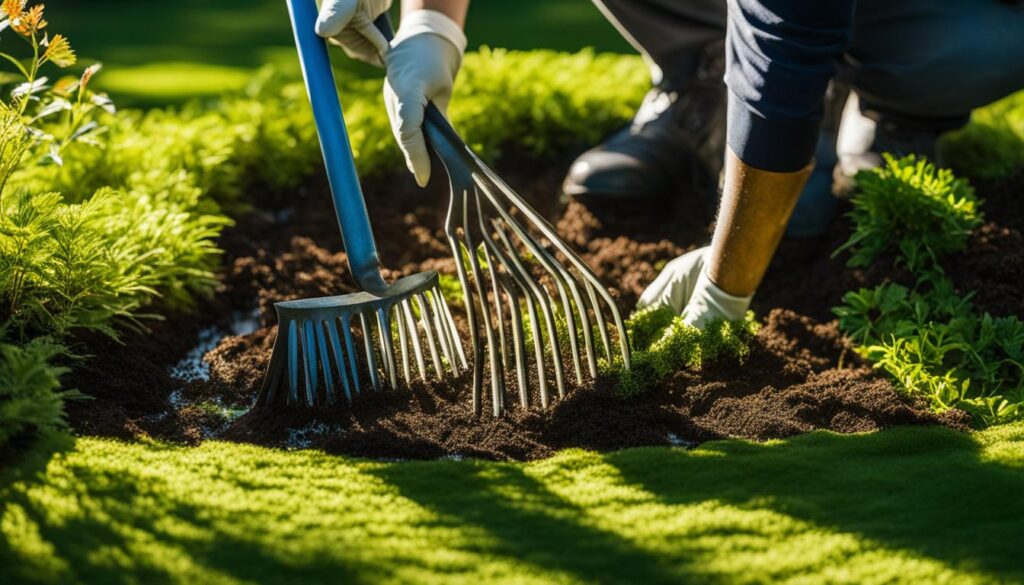
Moss Lawn Benefits for the Environment
When it comes to the environment, moss lawns offer a range of benefits that make them a great choice for eco-conscious homeowners. Let’s explore some of the advantages:
- Moss as an Air Purifier: Moss has the amazing ability to absorb nutrients directly from the atmosphere. This unique characteristic makes moss lawns effective air purifiers, as they help remove pollutants and improve air quality.
- Water Conservation: Unlike traditional grass lawns that can be water-intensive, moss lawns require significantly less water. Moss is naturally adapted to retain moisture, allowing it to thrive in shady and damp areas without the need for excessive irrigation. As water scarcity becomes a growing concern, opting for a moss lawn can be an environmentally responsible choice, especially in regions prone to droughts or hosepipe bans.
- Biodiversity and Habitat Creation: Moss lawns contribute to biodiversity by providing a habitat for various wildlife. The soft and lush moss offers shelter, food, and nesting opportunities for insects, birds, and small mammals. By embracing moss lawns, we can play a part in preserving and promoting the diversity of local flora and fauna.
Converting a portion of traditional lawns to moss lawns can have a positive impact on the environment. The benefits extend beyond aesthetics and low maintenance; moss lawns actively contribute to creating a greener and more sustainable ecosystem for future generations to enjoy.
Moss Lawn Benefits for the Environment
| Benefit | Description |
|---|---|
| Air Purification | Moss lawns absorb pollutants from the air, improving air quality. |
| Water Conservation | Moss lawns require less water compared to traditional grass lawns, making them a sustainable option. |
| Biodiversity and Habitat Creation | Moss lawns provide a habitat for various wildlife, promoting biodiversity. |
Moss Lawn vs Grass Lawn
When considering the choice between a moss lawn and a grass lawn, it’s important to understand the differences in characteristics and maintenance requirements. Moss, with its unique attributes, offers an alternative to traditional grass lawns that can thrive in unfavorable conditions such as poor soil, shade, and slopes. Grass, on the other hand, requires more water, sunlight, and high-quality soil to flourish.
Let’s take a closer look at the key differences between moss lawns and grass lawns:
Moss Adaptability
Moss is incredibly adaptable and can grow in conditions where grass would struggle. It thrives in poor soil quality, shaded areas, and sloped landscapes. This makes moss a suitable ground cover option for areas that are not conducive to grass growth.
Grass Requirements
Grass lawns, on the other hand, require more specific conditions to thrive. They need well-draining, nutrient-rich soil and a sufficient amount of sunlight. Grass lawns also demand regular watering, mowing, and fertilizing to maintain their health and appearance.
Moss in Grass
It’s not uncommon to find patches of moss growing within a grass lawn. The presence of moss within a lawn usually indicates unfavorable conditions for grass growth. Moss can thrive in areas where the grass is struggling due to shade, compacted soil, or poor drainage. It’s important to address these underlying issues to prevent moss from taking over the grass lawn.
Preventing Moss in Grass Lawns
To prevent moss from growing in a grass lawn, it’s essential to improve the overall health of the lawn. Here are a few tips:
- Improve Soil Health: Enhance soil drainage and nutrient levels by aerating the lawn and adding organic matter like compost.
- Reduce Shade: Trim trees or shrubs that may be casting excessive shade over the lawn.
- Promote Air Circulation: Avoid overwatering the lawn, as excess moisture can create favorable conditions for moss growth. Allow the grass to dry out between watering.

“Moss is incredibly adaptable and can grow in conditions where grass would struggle.”
By addressing soil health, shade, and moisture levels, you can create an environment that favors grass growth and discourages moss. Regular lawn care practices such as proper watering, mowing at the correct height, and aeration can also help maintain a healthy grass lawn.
Moss Lawn Care FAQs
Here are some frequently asked questions about moss lawn care:
-
Can you walk on a moss lawn?
Yes, most mosses can withstand light foot traffic, but adding a path or stepping stones can help reduce footfall.
-
Does moss need to be watered?
Moss does not need to be watered as frequently as grass. It can absorb moisture from the air, but during dry periods, light watering may be needed.
-
Are moss lawns expensive?
Moss lawns can be more expensive to install compared to sowing grass seed, but they require minimal maintenance, saving on long-term costs.
-
How do I remove moss from a grass lawn?
Moss can be raked or manually removed from a grass lawn. Improving soil health and lawn care practices can also prevent moss growth.
-
How do I control moss in a garden?
Regular weeding and proper garden maintenance can help prevent moss from overtaking other plants. Avoid using herbicides as they can harm moss and the environment.
Conclusion
In conclusion, moss lawns are an excellent choice for homeowners looking for a green and eco-friendly alternative to traditional grass lawns. With their numerous benefits, moss lawns provide a year-round lush greenery that requires less water and maintenance compared to traditional turf lawns.
When installing a moss lawn, it is crucial to properly prepare the area by clearing any debris and establishing good contact between the moss and soil. Regular maintenance, such as weeding and cleaning, is necessary to ensure the health and longevity of the moss lawn.
By opting for a moss lawn, you not only create a beautiful outdoor space but also contribute to the environment. Moss lawns purify the air by removing pollutants and require less water, making them an environmentally friendly choice. Enjoy the benefits of a moss lawn, such as its durability, low maintenance, and eco-friendliness, and transform your yard into a vibrant and sustainable oasis. Forget-Me-Nots are the perfect addition to a moss lawn, adding pops of blue to complement the lush green. These delicate flowers are not only beautiful, but also eco-friendly, attracting pollinators and adding a touch of nature to your garden. Brighten your space with forgetmenots and create a vibrant, sustainable oasis. Yes, most mosses can withstand light foot traffic, but adding a path or stepping stones can help reduce footfall. Moss does not need to be watered as frequently as grass. It can absorb moisture from the air, but during dry periods, light watering may be needed. Moss lawns can be more expensive to install compared to sowing grass seed, but they require minimal maintenance, saving on long-term costs. Moss can be raked or manually removed from a grass lawn. Improving soil health and lawn care practices can also prevent moss growth. Regular weeding and proper garden maintenance can help prevent moss from overtaking other plants. Avoid using herbicides as they can harm moss and the environment.How Can Forget-Me-Nots Complement a Moss Lawn for a Green and Eco-Friendly Garden?
FAQ
Can you walk on a moss lawn?
Does moss need to be watered?
Are moss lawns expensive?
How do I remove moss from a grass lawn?
How do I control moss in a garden?
- About the Author
- Latest Posts
Introducing Ron, the home decor aficionado at ByRetreat, whose passion for creating beautiful and inviting spaces is at the heart of his work. With his deep knowledge of home decor and his innate sense of style, Ron brings a wealth of expertise and a keen eye for detail to the ByRetreat team.
Ron’s love for home decor goes beyond aesthetics; he understands that our surroundings play a significant role in our overall well-being and productivity. With this in mind, Ron is dedicated to transforming remote workspaces into havens of comfort, functionality, and beauty.
Plants
Ideal Hydrangea Spots: Best Place to Plant Hydrangeas
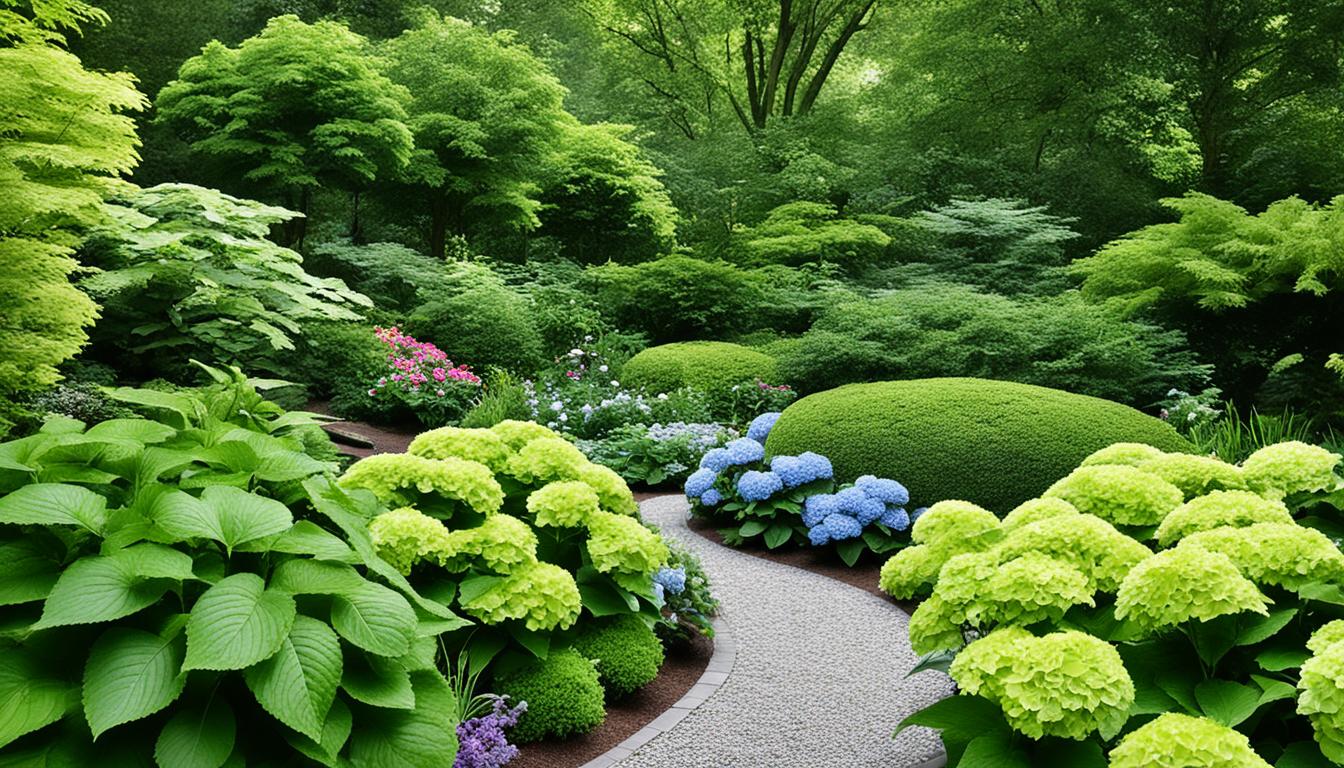
Did you know that the location where you plant your hydrangeas can have a significant impact on their growth and vibrancy? Finding the best place to plant hydrangeas is essential for optimal growth and to ensure that you get the most beautiful blooms.
In this guide, we will explore the different factors to consider when selecting the ideal spot for your hydrangeas. Whether you have a sunny garden or a shady corner, we’ll help you choose the right hydrangea varieties to thrive in various sun and shade conditions. By understanding their sunlight preferences and caring for them properly, you can enjoy vibrant and healthy hydrangea blooms year after year.
Key Takeaways:
- Choosing the right location is crucial for the growth and vibrancy of hydrangeas.
- Hydrangeas can thrive in different sunlight conditions, from full sun to partial shade.
- Consider the specific sunlight needs of different hydrangea varieties for optimal results.
- Proper care, including pruning, fertilizing, and watering, is essential for healthy blooms.
- By following our planting guide and care tips, you can transform your garden with stunning hydrangea displays.
Hydrangeas for Part Shade: Give Us Some Sunblock Please
When it comes to creating the perfect environment for hydrangeas, finding the right balance of sun and shade is key. While some hydrangea varieties thrive in full sun, others prefer a location with partial shade, where they can benefit from the morning sun and enjoy relief from the scorching afternoon rays. These hydrangeas are like beachgoers who know the importance of sunblock, seeking a little shade to protect themselves from the intense heat.
In the family of hydrangeas, there are several popular cultivars that are well-suited for part shade conditions. These varieties have the ability to produce stunning blooms when provided with a combination of filtered light and a few hours of full sun. Among them are the beloved Endless Summer® Hydrangea series, which includes BloomStruck®, Endless Summer®, Blushing Bride®, and Twist-n-Shout®.
Another great choice for morning sun and afternoon shade is the Annabelle Hydrangea, which is known for its spectacular large white flowers. And let’s not forget the many bigleaf hydrangea cultivars that can handle part shade and reward you with their vibrant blossoms.
Here are a few remarkable hydrangea varieties that thrive in part shade:
| Hydrangea Variety | Light Requirements |
|---|---|
| Endless Summer® series (BloomStruck®, Endless Summer®, Blushing Bride®, Twist-n-Shout®) | Morning sun, afternoon shade |
| Annabelle Hydrangea | Morning sun, afternoon shade |
| Bigleaf hydrangea cultivars | Morning sun, afternoon shade |
These hydrangeas have adapted to thrive in part shade by enjoying the gentle morning sun and being sheltered from the intense afternoon heat. This combination of light conditions allows them to produce their enchanting blooms and add a touch of elegance to any garden or landscape.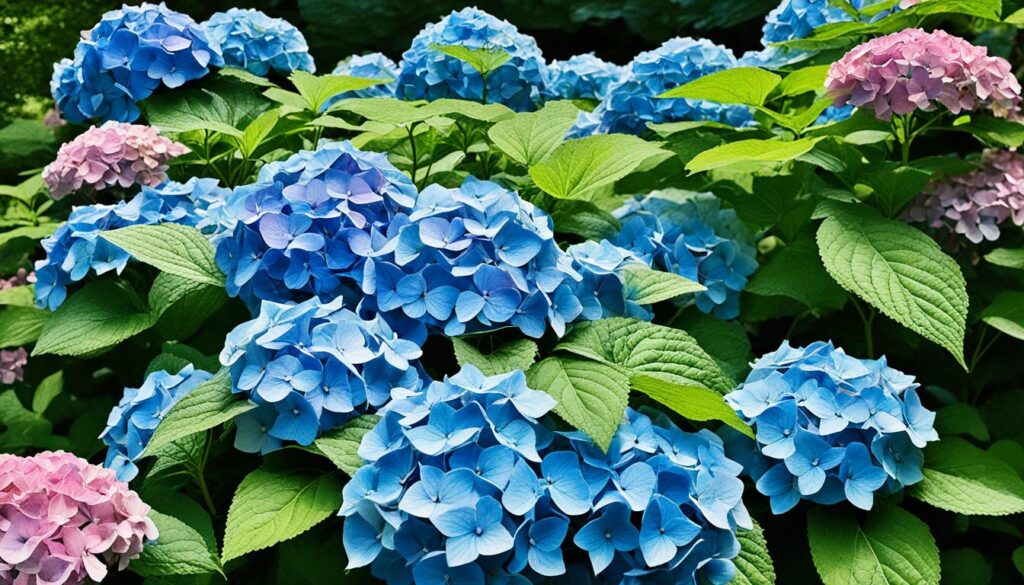
So, if you have a garden or yard with a mix of sunlight and shade, don’t worry! There are plenty of beautiful hydrangeas that will thrive in this environment. Just give them some sunblock (in the form of morning sun) and watch as their blooms light up your space with their breathtaking beauty.
Hydrangeas for Full Sun: We Like It Sunny
While most hydrangeas prefer some shade, there are certain varieties that can thrive in full sun. If your garden gets plenty of sunlight, don’t worry! There are hydrangeas that will flourish in these conditions and reward you with beautiful blooms.
Panicle Hydrangeas
Panicle hydrangeas, known for their cone-shaped flower clusters, are excellent choices for full sun exposure. They can tolerate the direct heat and intense sunlight, making them perfect for sunny spots in your garden. Some popular panicle hydrangeas include:
- Fire Light®
- Limelight
- Pinky Winky®
- Strawberry Sundae®
- Vanilla Strawberry®
Dwarf Varieties
If you have limited space or prefer compact hydrangeas, consider the Let’s Dance® and Cityline® series. These dwarf varieties are perfect for both full sun and part sun environments. They offer the beauty of hydrangeas in a smaller package without compromising on vibrant blooms.
Smooth Hydrangeas
Smooth hydrangeas are another type that can handle full or part sun conditions. These varieties are known for their large rounded flower heads and are a great choice for a sunny garden. Consider the following smooth hydrangeas:
- Incrediball®
- Invincibelle® Ruby
With these hydrangeas, you can enjoy the beauty and charm of these flowering plants even in full sun areas. Just make sure to provide them with proper care and maintenance, including regular watering and occasional fertilization.
Overall, including hydrangeas that thrive in full sun can add a splash of color and vibrancy to your garden. Whether you choose panicle hydrangeas, dwarf varieties, or smooth hydrangeas, these sun-loving beauties will brighten up any sunny corner of your outdoor space.
Growing Hydrangeas in Different Sun and Shade Conditions
When it comes to growing hydrangeas, understanding their sunlight requirements is essential for their success. While many hydrangea varieties thrive in partial shade, oakleaf hydrangeas are known for their adaptability to different sun and shade conditions.
In the northern parts of the United States, oakleaf hydrangeas can tolerate full sun. However, in warmer and southern climates, they prefer some afternoon shade to protect them from excessive heat and sun exposure. This makes them an excellent choice for those looking to plant hydrangeas in regions with varying temperature and sunlight conditions.
What makes oakleaf hydrangeas unique is their ability to also tolerate full shade. This makes them ideal for areas of the garden that receive little to no direct sunlight. Whether it’s a densely shaded corner or underneath taller trees, oakleaf hydrangeas can thrive and add beauty to areas that are typically challenging for other hydrangea varieties.
It’s important to note that while oakleaf hydrangeas are the most adaptable, other hydrangea varieties have specific sunlight needs. When selecting the location for planting, it’s crucial to consider the specific requirements of each hydrangea type to ensure optimal growth and vigor.
By carefully assessing the sunlight conditions in your garden and selecting the appropriate hydrangea varieties, you can create a diverse and captivating display of hydrangeas that thrive in different sun and shade conditions.
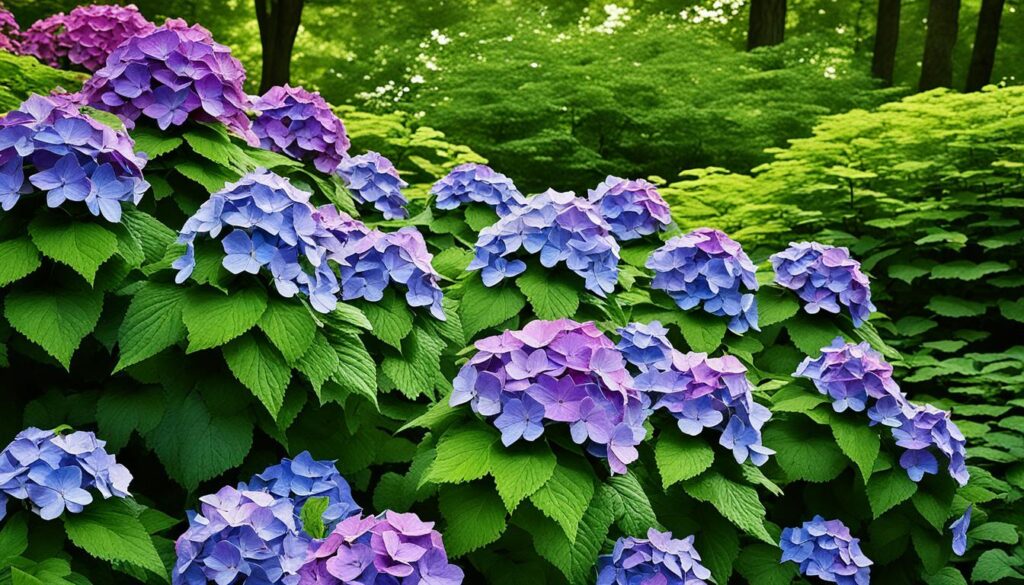
Pruning and Caring for Hydrangeas
Proper pruning and care are essential for the health and vitality of hydrangeas. By implementing appropriate pruning techniques and providing the necessary care, gardeners can ensure the longevity and abundant blooming of their hydrangea plants. Here are some important tips to consider:
Understanding Pruning Methods
When pruning hydrangeas, it’s crucial to understand whether the plant blooms on old wood or new wood. This knowledge will help gardeners avoid accidentally cutting off next season’s flowers.
Tip: Prune hydrangeas that bloom on old wood immediately after flowering. This allows for new growth and development of flower buds for next year. On the other hand, hydrangeas that bloom on new wood can be pruned during late winter or early spring before new growth begins.
Optimal Soil Conditions
Hydrangeas thrive in well-drained soil that is rich in organic matter. A mixture of compost and native soil is ideal for providing the necessary nutrients and moisture retention.
Fertilizing for Healthy Blooms
To promote healthy blooming, it’s recommended to fertilize hydrangeas with a slow-release fertilizer that is high in phosphorus. Phosphorus is essential for promoting flower production and overall plant vitality.
Preventing Leaf Scorch
Hydrangeas are susceptible to leaf scorch, especially during hot and dry periods. To prevent leaf scorch, it’s important to provide hydrangeas with extra water and ensure they have adequate moisture in the soil.

Summary of Pruning and Care Tips
| Pruning Method | Soil Conditions | Fertilizing | Preventing Leaf Scorch |
|---|---|---|---|
| Prune hydrangeas that bloom on old wood immediately after flowering | Well-drained soil with organic compost | Use slow-release fertilizer high in phosphorus | Provide extra water during hot and dry periods |
By following these pruning and care tips, hydrangea enthusiasts can enjoy lush, vibrant blooms year after year. With proper maintenance, these stunning plants will continue to beautify gardens and landscapes.
Conclusion
Planting hydrangeas in the best location and providing proper care and maintenance are key to achieving beautiful and vibrant blooms. By selecting the right spot that balances sun and shade, ensuring well-drained soil, and following recommended pruning and watering practices, gardeners can enjoy the full potential of their hydrangea plants. With the right planting and care, hydrangeas can transform any garden into a colorful and inviting space.FAQ
What is the best place to plant hydrangeas?
What are the best types of hydrangeas for morning sun and afternoon shade?
Can hydrangeas grow in full sun?
Which hydrangea varieties are best for full shade?
How should I prune and care for hydrangeas?
Are there any tips for planting and caring for hydrangeas?
- About the Author
- Latest Posts
Meet Katherine, the creative enthusiast at ByRetreat who infuses her boundless passion for design into every remote workspace she crafts. With an innate sense of creativity and an eye for unconventional beauty, Katherine brings a unique and inspiring perspective to the team.
Katherine’s love for design is infectious, and her ability to think outside the box sets her apart. She believes that true artistry lies in embracing a variety of styles and mixing them harmoniously to create captivating spaces. By combining different textures, colors, and patterns, Katherine weaves a tapestry of creativity that breathes life into each remote workspace.
Plants
Grow Zucchini Successfully: Best Way & Tips

Did you know that zucchini plants are susceptible to squash vine borers, a pest that can quickly kill the plants by cutting off the flow of water? The impact of these destructive borers can be devastating to your zucchini harvest. However, by following the best practices and tips for growing zucchini, you can ensure successful cultivation and enjoy a bountiful harvest.
Whether you are a seasoned gardener or a novice looking to try your hand at gardening, this article will provide you with valuable insights on the best way to grow zucchini and tips for successful cultivation. From avoiding squash vine borers to proper planting techniques, soil requirements, spacing, and pollination, we will cover everything you need to know to grow zucchini successfully.
Key Takeaways:
- Delay planting zucchini until mid-July or use row covers to prevent squash vine borers
- Start zucchini from seeds or seedlings and choose the right time to plant
- Provide well-draining soil enriched with organic material for optimal growth
- Space zucchini plants at least 3-4 feet apart and consider trellising for better air circulation
- Ensure proper pollination for optimal fruit production and harvest zucchini at any size
Planting and Germination
Zucchini, a popular summer squash variety, can be easily grown from seeds or seedlings. While starting zucchini indoors is an option, direct sowing in the ground is the preferred and most common method of planting zucchini seeds. Here’s a step-by-step guide to planting zucchini seeds and ensuring successful germination:
1. Prepare the Soil
Before starting zucchini indoors or sowing the seeds outside, it’s crucial to have well-prepared soil. Ensure the soil is loose, rich in organic matter, and drains well. Incorporating compost or aged manure can greatly improve the soil’s fertility. Measure the soil temperature and wait until it consistently reaches above 55 degrees Fahrenheit for successful germination.
2. Planting Zucchini Seeds
When the soil is ready, plant the zucchini seeds about an inch deep into the soil. Space the seeds at least 3 feet apart to allow ample room for growth. Lightly mist the top of the soil with water to ensure proper moisture levels for the germination of zucchini. Take care not to overwater the seeds, as it can lead to rotting.
Pro Tip: For those who prefer starting zucchini indoors, plant the seeds in peat pots or biodegradable seed starting trays about 2-3 weeks before the last expected frost. Transplant the seedlings outdoors once the soil temperature is suitable.
3. Germination and Thinning
The germination period of zucchini seeds typically ranges from 5 to 10 days. During this time, it’s important to keep the soil consistently moist but not waterlogged. Once the seedlings reach a height of around 3 inches and develop 2 sets of true leaves, it’s time to thin them out. Starting zucchini indoors often leads to more seedlings, so removing the weaker ones will allow the strongest ones to flourish.
4. Timing is Key
For optimal growth, it’s crucial to plant zucchini at the right time. Zucchini thrives in warm soil, so direct sowing should take place in the second half of May when the risk of frost has passed and the soil has warmed up. This timing ensures that the young seedlings will not succumb to cold temperatures.
“Direct sowing zucchini seeds is the most practical and successful method for home gardeners. The plants quickly establish themselves and produce abundant healthy foliage and fruit.” – Gardening Expert, Jessica Washington
By following these planting zucchini seeds and germination guidelines, you can give your zucchini plants a head start in their growth journey. Whether you choose to start the seeds indoors or directly sow them in the ground, with proper care and attention, you’ll soon be rewarded with healthy zucchini plants ready to produce an abundance of delicious squash.
| Benefits of Direct Sowing Zucchini Seeds | Benefits of Starting Zucchini Indoors |
|---|---|
| 1. Simplifies the planting process | 1. Provides an earlier start to the growing season |
| 2. Minimizes transplant shock | 2. Offers more control over seedling development |
| 3. Allows seeds to germinate and grow in their natural environment | 3. Enables better protection against adverse weather conditions |
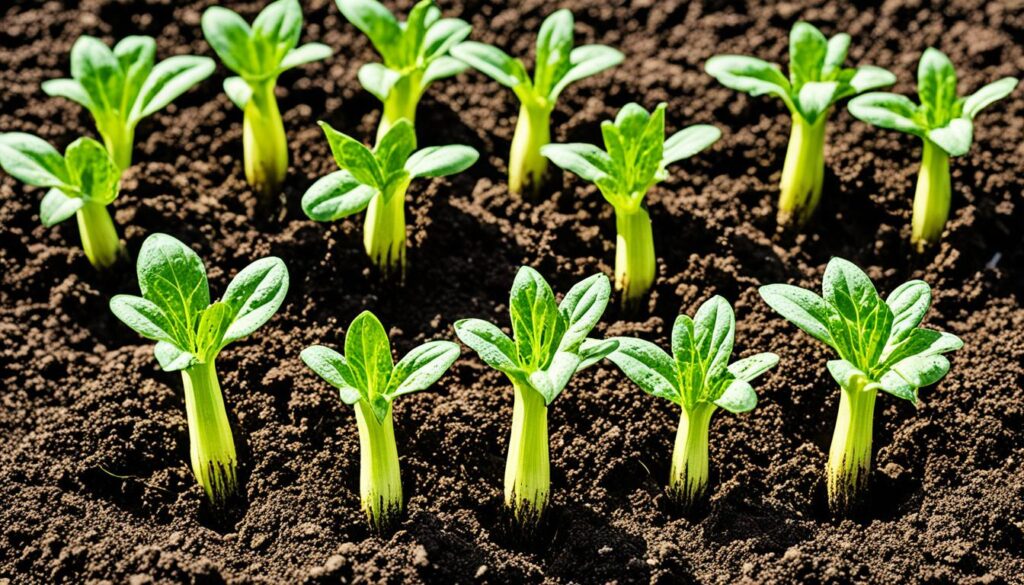
Soil and Location Requirements
Zucchini plants require specific soil and an ideal location to thrive and produce a bountiful harvest. Providing the right conditions for your zucchinis will ensure their health and productivity.
Choosing the Best Soil
Zucchini plants prefer organically rich, fertile, and well-draining soil. When planting in raised beds or containers, it is essential to select a well-draining potting soil. To enhance the soil’s fertility, add organic material or compost at the time of planting. This will help create a nutrient-rich environment for the zucchini plants to thrive.
If you are planting zucchinis directly in the ground, it is crucial to amend the soil with rich organic material or compost. This will improve the soil’s texture and provide the necessary nutrients for the plants to grow strong and healthy. Additionally, good drainage is essential for zucchini plants, as they prefer moist but not waterlogged conditions.
Choosing the Ideal Location
When selecting a location for your zucchini plants, it is important to consider their sunlight requirements. Zucchinis thrive in areas that receive full sun for at least 6-8 hours a day. Choose an area in your garden that is not shaded by buildings or trees, as this can hinder their growth and development.
Furthermore, it is important to note that zucchinis should not be planted in soil where other cucurbits (such as pumpkins or cucumbers) were grown in the past 1-2 years. This practice helps prevent the spread of diseases and pests that may affect the zucchini plants.
By providing the right soil conditions and selecting an ideal location with ample sunlight, you will create an optimal environment for your zucchini plants to flourish and produce an abundant crop.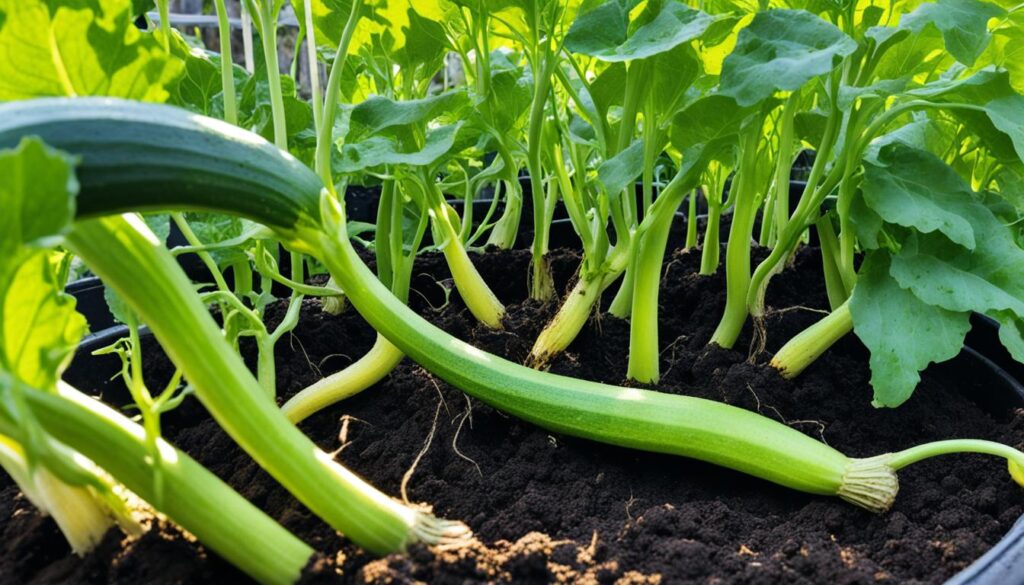
“Zucchini plants prefer organically rich, fertile, and well-draining soil. Provide the right conditions to help your zucchini plants thrive and produce a bountiful harvest.”
Spacing and Trellising
Proper spacing and trellising techniques are essential for the successful growth and development of zucchini plants.
Spacing Zucchini Plants
When it comes to zucchini plant spacing, giving enough room for each plant is crucial for optimal growth. It is recommended to space zucchini plants at least 3-4 feet apart, whether planting them in hills or rows.
For planting in hills, a general guideline is to plant 3 zucchinis per hill in a triangle pattern. Ensure the hills are also spaced 3-4 feet apart to provide enough space for the plants to receive nutrients and expand their root systems.
If growing zucchinis in containers, create a mound in the center of the container and plant three zucchinis around it. This arrangement allows for adequate airflow and efficient use of space while providing the plants with the necessary growing area.
Trellising Zucchini
Another option for maximizing space and aiding in pest management is trellising zucchini plants. By training them to grow vertically along a trellis or stakes, you can create a visually appealing and space-saving garden.
When trellising zucchini, ensure that the trellis or stakes are sturdy enough to support the weight of the plants and their fruit. As the zucchinis grow, gently guide the vines and tendrils toward the trellis, securing them with twist ties or plant clips.
The benefits of trellising zucchini include improved air circulation, which helps prevent disease, easier harvesting, and reduced pest damage since the plants are elevated off the ground.
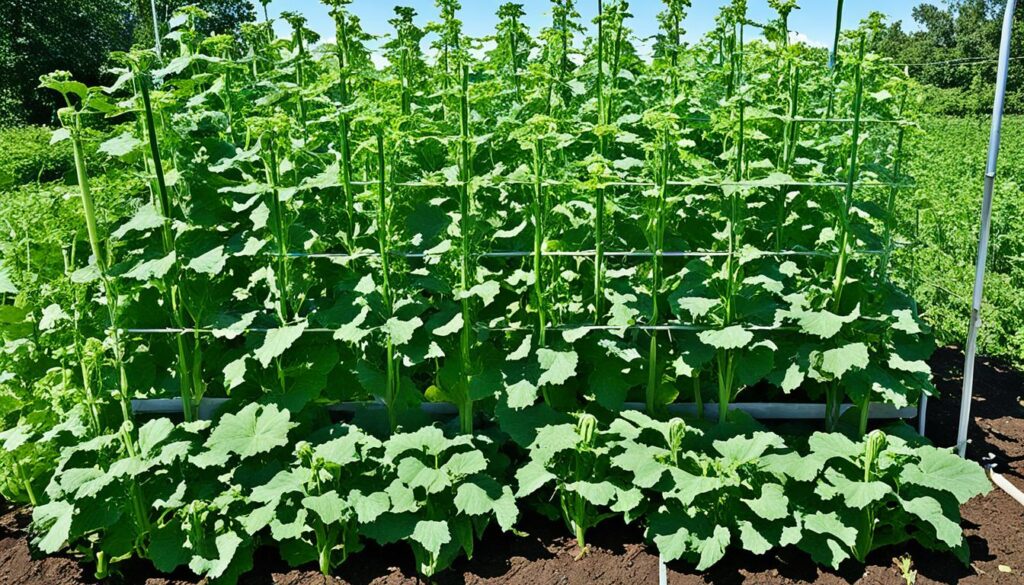
Implementing proper spacing and trellising techniques ultimately promotes healthier zucchini plants, increased productivity, and efficient use of garden space.
Pollination and Fruit Production
Zucchini plants rely on pollination for fruit production. These plants have separate male and female flowers, and the transfer of pollen from the male to the female flowers is crucial for the development of zucchini fruits. To ensure successful pollination, it’s important to understand how pollinators play a role in this process. 
Pollinators such as bees, butterflies, and other insects are attracted to the bright yellow flowers of zucchini plants. To maximize their presence in your garden, consider planting companion flowers like borage, catmint, dill, or dahlias nearby. These flowers will help attract pollinators, increasing the chances of successful pollination.
In some cases, there may be a lack of natural pollination due to factors such as weather conditions or a limited number of pollinators in the area. In such situations, manual pollination can be done to ensure fruit production. This process involves using a small brush or cotton swab to transfer pollen from the male flowers to the female flowers. By gently brushing the inside of the male flower and then transferring the pollen to the stigma of the female flower, you can help facilitate pollination.
Tip: To identify male and female flowers, look for the presence of a small zucchini-shaped swelling at the base of the female flower. Male flowers, on the other hand, do not have this swelling.
Proper pollination is essential for optimal fruit development. It ensures that the female flowers receive the necessary pollen for fertilization, leading to the formation of healthy zucchini fruits. Be sure to monitor the progress of your zucchini plants and check for signs of fruits developing from the female flowers.
When it comes to harvesting zucchini, you can do so at any size. However, larger zucchinis may have more developed seeds and a denser texture, which might not be desirable for certain recipes. In such cases, it is recommended to remove the seeds before consumption. This can be done by slicing the zucchini lengthwise and scooping out the seeds with a spoon.
Conclusion
Successful zucchini cultivation requires attention to several key factors, including avoiding squash vine borers, following proper planting techniques, providing the right soil and location, spacing plants correctly, and ensuring proper pollination. By implementing these tips and techniques, gardeners can enjoy a bountiful harvest of zucchinis that can be incorporated into a wide range of dishes.
The best way to grow zucchini is to start by carefully timing the planting, ensuring that soil temperatures are consistently above 55 degrees Fahrenheit. This warm soil temperature provides an ideal environment for germination and growth. Additionally, choosing a well-lit area with full sun for at least 6 hours a day will help zucchinis thrive.
When it comes to soil and location requirements, zucchini plants prefer organically rich and well-draining soil. Amend the soil with compost or rich organic material to promote healthy growth. Adequate spacing is essential for proper plant development, with a recommended distance of 3-4 feet between plants. Trellising zucchini plants can also save space and improve airflow.
Finally, ensuring proper pollination is crucial for maximizing fruit production. Planting companion flowers near zucchinis can attract beneficial pollinators, and manual pollination can be done to supplement natural pollination. Harvesting can be done at any size, but larger zucchinis may require seed removal before consumption.FAQ
When is the best time to plant zucchini?
How can I prevent squash vine borers from killing my zucchini plants?
What type of soil do zucchini plants prefer?
How should I space my zucchini plants?
Do zucchini plants require manual pollination?
Can I grow zucchini vertically?
- About the Author
- Latest Posts
Meet Katherine, the creative enthusiast at ByRetreat who infuses her boundless passion for design into every remote workspace she crafts. With an innate sense of creativity and an eye for unconventional beauty, Katherine brings a unique and inspiring perspective to the team.
Katherine’s love for design is infectious, and her ability to think outside the box sets her apart. She believes that true artistry lies in embracing a variety of styles and mixing them harmoniously to create captivating spaces. By combining different textures, colors, and patterns, Katherine weaves a tapestry of creativity that breathes life into each remote workspace.
Plants
Best Conditions for Ginger Root Growth Explained
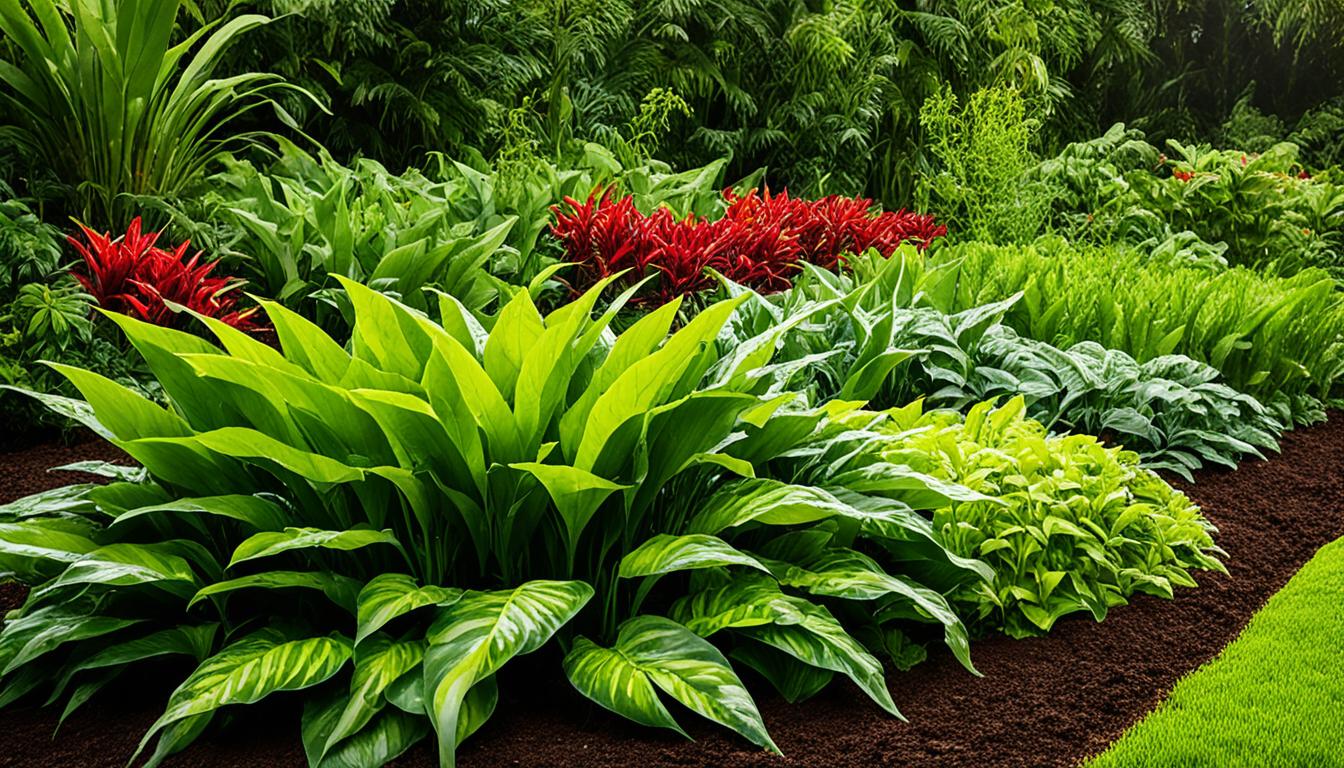
Ginger, known for its unique flavor and medicinal properties, is a versatile root used in everything from cooking to herbal remedies. But did you know that the success of ginger cultivation depends heavily on the conditions in which it is grown? Creating the best conditions for ginger root growth is essential to yield a bountiful harvest and vibrant plants.
From temperature to soil quality and moisture levels, each aspect plays a crucial role in ginger’s growth and well-being. By understanding the optimal conditions, gardeners and enthusiasts can replicate ginger’s tropical habitat and cultivate healthy plants with exceptional flavor and aroma.
In this article, we will explore the optimal conditions necessary for ginger root growth, offering insights and techniques to help you grow ginger successfully. Whether you’re an experienced gardener or a beginner with a green thumb, this guide will provide valuable knowledge to enhance your ginger cultivation.
Key Takeaways:
- Ginger root growth requires specific conditions to thrive.
- Temperature, soil quality, moisture, and shade are essential factors.
- Best practices include using organic matter, maintaining proper drainage, and providing dappled shade.
- Ginger can be grown in containers, hoop houses, or greenhouses.
- Pre-sprouting ginger indoors can maximize the growing season.
Optimal Soil Conditions for Ginger Root Growth
Ginger plants require optimal soil conditions to thrive and produce healthy root growth. By providing the right environment, gardeners can ensure that their ginger plants receive the necessary nutrients and support for robust growth. Here are some essential factors to consider when creating optimal soil conditions for ginger root growth:
- Rich in Organic Matter: Ginger prefers soil that is rich in organic matter, which provides essential nutrients and promotes healthy root development. Adding lots of compost to the ground or using a peat and wood bark-based soilless medium mixed with sand in containers can help create a fertile growing medium.
- Organic Fertilizers and Worm Castings: Supplementing the soil with organic fertilizers and worm castings can further enhance the nutrient content, ensuring that ginger plants have access to the necessary elements for their growth. These natural amendments provide a slow-release source of nutrients, promoting long-term plant health.
- Good Drainage: It is crucial to ensure good drainage in the soil to prevent waterlogging, as standing water can negatively affect ginger growth. To improve drainage, incorporating coarse sand or perlite into the soil can help create a well-draining environment for the roots.
- pH Levels: Maintaining the right pH levels is essential for optimal ginger growth. Ginger plants prefer slightly acidic soil, with pH levels between 5.5 and 6.5. Testing the soil’s pH and making appropriate adjustments using organic soil amendments or sulfur can help create the ideal conditions for ginger plants.
By creating soil conditions that are rich in organic matter, well-draining, and with the right pH levels, gardeners can provide the optimal environment for ginger root growth. The next section will explore the ideal temperature range for ginger plants and the impact it has on their growth and development.
Soil Conditions for Ginger Root Growth
| Soil Condition | Description |
|---|---|
| Rich in organic matter | Ginger prefers soil that is rich in organic matter, such as compost or a peat and wood bark-based soilless medium mixed with sand. |
| Organic fertilizers and worm castings | Adding organic fertilizers and worm castings can provide essential nutrients for ginger plants. |
| Good drainage | Ensuring good drainage in the soil is crucial to prevent waterlogging, which can negatively affect ginger growth. |
| pH levels between 5.5 and 6.5 | Maintaining slightly acidic soil with pH levels between 5.5 and 6.5 is ideal for ginger plants. |

Ideal Temperature Range for Ginger Root Growth
Ginger is a tropical plant that thrives in warm temperatures, making the ideal temperature range a crucial factor for its successful growth. The ideal temperature range for ginger root growth is 70° to 90°F (21° to 32°C). This range provides the optimal conditions for ginger plants to thrive and produce healthy rhizomes.
When growing ginger, it is important to consider the nighttime temperatures as well. It is recommended to plant ginger when nighttime temperatures are consistently above 55°F (13°C). Cooler temperatures can slow down the growth of ginger plants or even cause damage to them, hindering their development.
In regions with colder climates, it may be challenging to maintain these ideal temperatures for ginger growth. However, there are ways to overcome this obstacle and still grow ginger successfully. Growing ginger indoors in a controlled environment, such as a greenhouse or conservatory, can provide the necessary warmth for ginger plants to thrive.

Importance of Moisture for Ginger Root Growth
Ginger is a moisture-loving plant that requires consistent watering to thrive and produce healthy and flavorful roots. Proper moisture management is essential for ginger root growth.
The soil should be kept evenly moist, providing enough water to meet the plant’s needs without overwatering or allowing the soil to dry out completely. Overwatering can lead to waterlogged conditions, which can suffocate the roots and promote the development of root rot. Conversely, letting the soil dry out completely can cause stress to the plant and hinder its growth.
Watering frequency may vary depending on factors such as the climate, humidity levels, and container size. In general, it is advisable to water ginger plants whenever the top inch of soil feels slightly dry. This allows for proper hydration without risking waterlogging.
Proper irrigation techniques and good drainage are crucial for maintaining the ideal moisture levels for ginger root growth. In containers, ensure that there are drainage holes to prevent water from pooling at the bottom. For in-ground planting, selecting a well-draining soil or amending the soil with organic matter can improve moisture balance.
Expert Tip:
When watering ginger plants, it’s important to give them a deep soak, allowing the water to penetrate the root zone. However, avoid overhead watering as it can lead to the development of fungal diseases. Instead, direct the water towards the base of the plant or use a drip irrigation system to ensure precise watering.
By maintaining the right moisture levels through proper watering techniques and good drainage, gardeners can provide the optimal conditions for ginger root growth, ensuring healthy plants and a bountiful harvest.

Moisture Guidelines for Ginger Root Growth
| Moisture Level | Signs | Recommended Action |
|---|---|---|
| Soggy or Waterlogged | Wilting, yellowing leaves; foul odor; root rot | Improve drainage by adding organic matter; reduce watering frequency |
| Too Dry | Wilting, dry soil; slow growth | Increase watering frequency; mulch around plants to retain moisture |
| Evenly Moist | Healthy foliage; steady growth | Continue regular watering; monitor moisture levels |
Benefits of Dappled Shade for Ginger Root Growth
Ginger plants thrive in dappled shade, which provides them with a balanced environment for optimal growth. The benefits of dappled shade include protection from direct sunlight, prevention of soil overheating and excessive drying, and maintenance of suitable moisture levels.
Planting ginger under the shelter of taller crops or using shade cloth can create the perfect conditions for ginger root growth. The dappled shade allows the plants to receive filtered sunlight, which is essential for photosynthesis while reducing the risk of sunburn or heat stress.
“Dappled shade is like a natural sunscreen for ginger plants, shielding them from the harsh rays of the sun and maintaining a cool, comfortable environment.”
By providing dappled shade, you can create an ideal microclimate for ginger root growth. The shade helps regulate soil temperatures, preventing it from becoming too hot and drying out too quickly. This is particularly important for ginger, as it prefers consistently moist soil.
Moreover, dappled shade helps to reduce water evaporation, allowing the roots to stay moist for longer periods. This helps the ginger plants establish a strong root system and absorb essential nutrients from the soil, promoting healthy growth and development.
When setting up dappled shade for your ginger plants, it is important to strike a balance. While providing shade, ensure that there is still enough light penetration for proper photosynthesis. Ginger plants need adequate sunlight to produce energy for growth, but too much direct sunlight can be detrimental.
Consider planting ginger in an area where it receives morning sun and partial afternoon shade. This allows the plants to benefit from the warmth and light of the morning sun while being shielded from the intense heat of the afternoon sun.
To summarize, dappled shade provides numerous benefits for ginger root growth, including protection from direct sunlight, prevention of soil overheating and excessive drying, and maintenance of suitable moisture levels. By implementing dappled shade techniques, you can create an ideal environment for ginger plants to thrive and produce a bountiful harvest.
Pros and Cons of Dappled Shade for Ginger Root Growth
| Benefits of Dappled Shade | Considerations for Dappled Shade |
|---|---|
| Protection from direct sunlight | Ensure there is still enough light for photosynthesis |
| Prevents soil overheating | Find a balance between shade and sunlight |
| Reduces soil drying out | Choose an area with morning sun and partial afternoon shade |
| Maintains suitable moisture levels |

Recommended Planting Techniques for Ginger Root Growth
When it comes to cultivating ginger, selecting the right planting technique is crucial for successful root growth. Whether using whole rhizomes or cut pieces, understanding the proper methods will optimize your ginger harvest. Here are some recommended planting techniques:
1. Using Whole Rhizomes
Planting ginger with whole rhizomes is a straightforward technique that yields excellent results. Look for healthy, plump rhizomes with well-developed buds or eyes. These larger rhizomes tend to grow quicker and produce more robust plants.
To plant whole rhizomes:
- Prepare the soil by loosening it with a garden fork or tiller.
- Dig a trench that is about 6 to 8 inches deep.
- Place the rhizomes in the trench with the eyes facing upwards.
- Cover the rhizomes with soil, ensuring they are well-buried but not too deep.
- Water gently to settle the soil.
2. Using Cut Rhizome Pieces
If you have limited planting material or want to maximize your ginger yield, using cut rhizome pieces is a viable option. When cutting the rhizomes, ensure each piece has at least one bud or eye.
To plant cut rhizome pieces:
- Prepare the soil or select a suitable container with good drainage.
- Fill the container with a well-draining potting mix or amend the soil with organic matter.
- Place the cut rhizome pieces in the soil or container, burying them about 1 to 2 inches deep.
- Water thoroughly to encourage root establishment.
Note: Make sure there is adequate room for the rhizomes to grow when planting in containers. This will prevent overcrowding and promote healthier plant development.
3. Pre-sprouting Indoors
For gardeners who wish to extend the growing season or gain a head start on ginger production, pre-sprouting indoors is an effective technique. This method involves placing the rhizomes in a tray with moist compost or paper towel to encourage early sprouting.
To pre-sprout ginger indoors:
- Select healthy rhizomes with visible eyes.
- Fill a tray with moist compost or lay paper towels on a flat surface.
- Place the rhizomes on the compost or paper towels, positioning them with the eyes facing upwards.
- Maintain the moisture level by misting regularly.
- Keep the tray or paper towels in a warm location with indirect sunlight.
- Once sprouts have developed, carefully transplant them into individual containers or directly into the ground.
Pre-sprouting allows for an earlier harvest and ensures that the ginger plants have a strong start before being exposed to outdoor conditions.
Remember, ginger responds well to a warm and humid environment, so providing the optimal conditions during the planting process will contribute to its overall growth and development.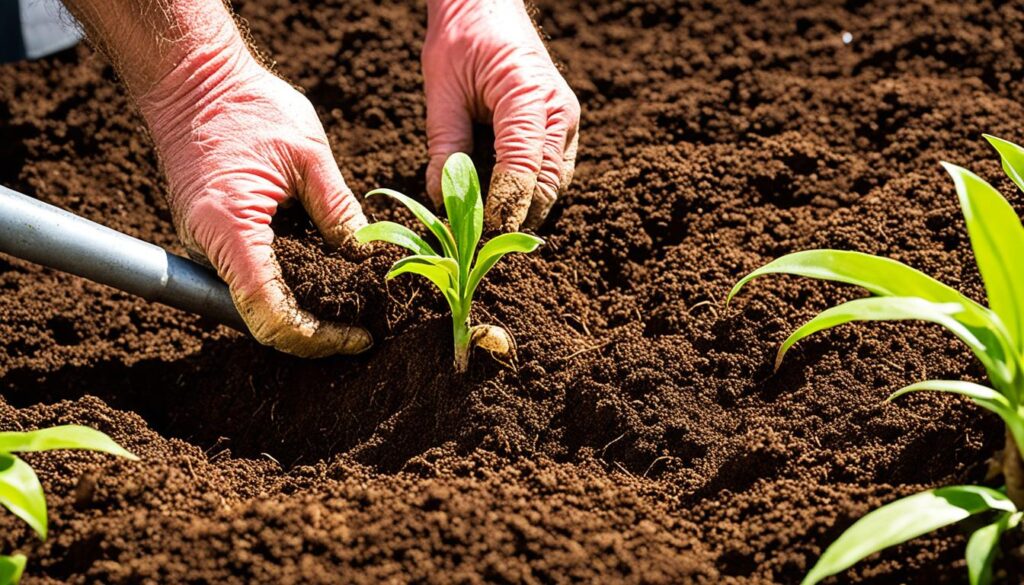
| Planting Technique | Advantages | Disadvantages |
|---|---|---|
| Using Whole Rhizomes | – Quicker growth – Larger harvests |
– Requires more planting material – Limited control over spacing |
| Using Cut Rhizome Pieces | – Maximizes planting material – Allows for precise spacing |
– Slower initial growth – Smaller rhizome yields |
| Pre-sprouting Indoors | – Provides an early start – Enhances germination rates |
– Requires additional indoor space – Requires regular misting |
Care Tips for Ginger Root Growth
Proper care is crucial for the successful growth of ginger roots. By providing the right conditions, you can ensure healthy plants and a bountiful harvest. Here are some essential care tips for ginger root growth:
1. Warmth: Ginger plants thrive in warm environments, so it’s important to provide them with a suitable temperature. During the summer, whether you are growing ginger outdoors or indoors, it’s beneficial to place the plants in a warm and humid area.
2. Humidity: Humidity is another important factor for ginger root growth. If you are growing ginger indoors, placing the plant near a bright windowsill can help simulate the ideal conditions. Additionally, occasional misting with water can create a humid environment that mimics the plant’s natural habitat.
3. Moisture: Adequate moisture levels are essential for ginger plants. It’s important to water the plants regularly, ensuring that the soil is evenly moist. However, be cautious not to overwater, as excessive moisture can lead to root rot. To promote proper drainage, use pots with drainage holes and allow the soil to dry out slightly between waterings.
4. Mulching: Applying a layer of mulch around ginger plants can serve multiple benefits. Mulching helps to conserve moisture in the soil, reducing the frequency of watering required. Additionally, it helps to suppress weed growth, keeping the area around the ginger plants clean and tidy.
Ginger plants require a combination of warmth, humidity, moisture, and proper drainage to thrive. By following these care tips, you can create optimal conditions for ginger root growth and enjoy a successful harvest.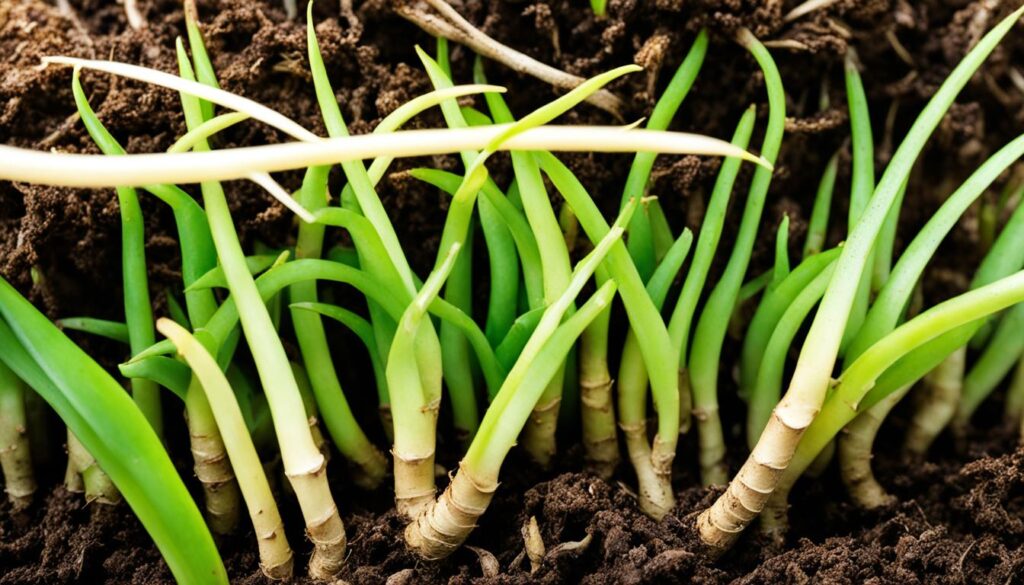
| Care Tips for Ginger Root Growth | Benefits |
|---|---|
| Provide warmth | Creates a favorable environment for ginger plants |
| Maintain humidity | Simulates the plant’s natural habitat and supports growth |
| Ensure proper moisture | Prevents drying out or waterlogging |
| Use mulch | Conserves moisture and suppresses weed growth |
Conclusion
Growing ginger successfully requires replicating its tropical natural habitat as closely as possible. Providing optimal soil conditions, the right temperature range, adequate moisture, and dappled shade is crucial. By following these best practices, gardeners can ensure the best conditions for ginger root growth and enjoy a bountiful harvest.
When it comes to planting ginger, there are two main methods: using whole rhizomes or cutting them into pieces and pre-sprouting indoors for an earlier harvest. Both approaches can be effective, but it’s important to pay careful attention to watering and drainage. Ginger cannot tolerate standing water or drying out completely, so finding the right balance is key.
Remember that ginger thrives in warm temperatures, ideally ranging from 70° to 90°F (21° to 32°C). Additionally, ginger plants appreciate some dappled shade, as it protects them from direct sunlight and helps prevent the soil from drying out too quickly. Creating these optimal conditions will give your ginger the best chance to grow and thrive.
So whether you’re growing ginger in the ground, in containers, or in a greenhouse, make sure to provide it with the right environment. By replicating its tropical natural habitat as closely as possible and paying attention to its specific needs, you can enjoy a bountiful harvest of delicious and aromatic ginger roots.
FAQ
What are the best conditions for ginger root growth?
What are the optimal soil conditions for ginger root growth?
What is the ideal temperature range for ginger root growth?
How important is moisture for ginger root growth?
What are the benefits of dappled shade for ginger root growth?
What are the recommended planting techniques for ginger root growth?
What are the care tips for ginger root growth?
- About the Author
- Latest Posts
Meet Katherine, the creative enthusiast at ByRetreat who infuses her boundless passion for design into every remote workspace she crafts. With an innate sense of creativity and an eye for unconventional beauty, Katherine brings a unique and inspiring perspective to the team.
Katherine’s love for design is infectious, and her ability to think outside the box sets her apart. She believes that true artistry lies in embracing a variety of styles and mixing them harmoniously to create captivating spaces. By combining different textures, colors, and patterns, Katherine weaves a tapestry of creativity that breathes life into each remote workspace.
-

 Vetted5 days ago
Vetted5 days ago15 Best Fillers for Concrete Cracks – Expert Recommendations and Reviews
-

 Vetted7 days ago
Vetted7 days ago15 Best Plants for Large Pots to Transform Your Outdoor Space
-

 Vetted6 days ago
Vetted6 days ago15 Best Fairy Lights to Transform Your Space With Magical Illumination
-

 Vetted1 week ago
Vetted1 week ago15 Best Folding Beds for Small Spaces – Space-Saving Solutions for Comfort and Convenience
-

 Vetted1 week ago
Vetted1 week ago15 Best Waterproof Flooring Options for Your Bathroom – Ultimate Guide & Reviews
-

 Vetted2 weeks ago
Vetted2 weeks ago15 Best Grocery Carts to Make Shopping a Breeze
-

 Vetted22 hours ago
Vetted22 hours ago15 Best Subfloor Options for Your Basement Renovation – Ultimate Guide
-

 Vetted3 weeks ago
Vetted3 weeks ago15 Best Gravel for Driveway: The Ultimate Guide for a Durable and Stunning Entrance


























